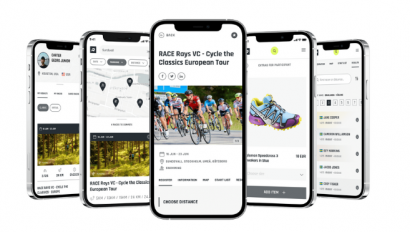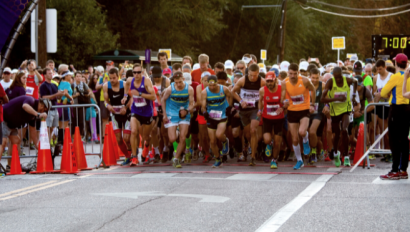How To Optimize Your Registration Process

As a race organizer, it’s crucial to recognize that the registration process is the first point of contact with your race participants. Make sure it is a positive first encounter! Why? Well, if your race is difficult to sign up for, participants might decide to skip it altogether. If it is easy then you’re guaranteed to attract more participants.
In this article, we explore some best practices for optimizing your race registration process. The aim is to increase the likelihood of participants completing the registration process and attending your race!
1. Streamline the event – Keep it simple!
Streamlining means simplifying and optimizing a process in order to improve efficiency and achieve better results. In the context of organizing a race, streamlining involves identifying areas that can be simplified and optimized to create a positive experience for participants. By streamlining the registration process, you can eliminate confusion, hesitation and make it easier for participants to sign up to your race.
First of all, decide on a date to open registrations. You should open your registrations as early as possible, and we explain why in our article about when it is the best time to open registrations here.
Secondly, make sure the registration process is easy to complete. Only collect essential information and avoid unnecessary steps that may discourage people from completing the registration process.
Thirdly, you should provide a user-friendly interface. Have clear instructions to help guide participants through the process smoothly whether they are using your website on their desktop or their mobile devices. We promise this will ultimately lead to more registrations and a more successful event.
If you are interested in learning about different race registration systems, check out our well-researched list of different race registration systems.
2. Offer online registration that is mobile-friendly
Making a race registration process mobile-friendly is a definite must in today’s digital age. With the widespread use of smartphones, more and more people are registering for events through their mobile devices. Therefore, optimizing the registration process for mobile devices can help increase registration rates. It can also improve the overall user experience for participants.
Here are 3 ways to make your race event registration process mobile-friendly:
- Use responsive design: Responsive design ensures that your registration page adapts to different screen sizes, making it easy to read and navigate on any device. Make sure to test the registration process on different mobile devices to ensure that it works well. This will help you identify any issues or barriers that need to be addressed.
- Simplify the registration form: Mobile devices have smaller screens, so it’s important to keep the registration form simple and easy to fill out. Avoid using long forms that require a lot of scrolling. Only ask for essential information!
- Use mobile-friendly payment options: Offer payment options that are easy to use on mobile devices, such as mobile wallets and payment gateways.
3. Provide early bird discounts to incentivize early registrations
The early bird catches the worm! Offering early bird discounts for events has several benefits:
First, it can lead to increased registrations! The incentive to save money can motivate people to register earlier than they might have otherwise. This can help increase overall attendance at the event.
Second, early bird discounts can help with cash flow management and budgeting. By collecting funds in advance, organizers can better plan and allocate resources for the event.
Third, early bird discounts create a sense of urgency for potential attendees to register sooner rather than later. This sense of urgency can increase the overall excitement for the event, which can further drive registrations.
Finally, early bird discounts can increase the visibility of the event and create buzz on social media and other marketing channels. This can help attract more attendees and generate more excitement for the event overall.
Want to find out how to get your early bird pricing right? Read this article!
4. Harness social media to promote the event and encourage registration
Social media is a powerful tool to promote your race and encourage more registrations. Even if your race is a small or local race, we bet that your participants are using social media in their daily lives! Make sure that the name of your race pops up when they search for it! Below you find some strategies to encourage registrations for your race event with social media:
- Create a dedicated event page: Creating a dedicated event page on social media platforms like Facebook can help to centralize information about the race and provide a place for discussion and engagement.
- Leverage paid social media advertising: Paid social media advertising can be a cost-effective way to target potential participants and drive registrations. You can use targeting options to reach specific demographics that are likely to be interested in your race.
- Use engaging visuals: High-quality visuals such as photos and videos can help to showcase the race event. Use eye-catching visuals that highlight the wonderful experience of participating in the race.
- Encourage user-generated content: Encourage participants to share their own content related to the race, and use event-specific hashtags to make it easy to find and share. This can help to create a sense of community around the race event.
- Collaborate with influencers: Partnering with influencers in the running or fitness communities can help to promote the race event to a wider audience. Look for influencers who align with the values and mission of the race event. They can help you generate excitement and interest among their followers!
Whether it be on Facebook, Instagram or TikTok, make sure you have a social media presence to help participants find and sign up to your race.
5. Communicate clearly and timely
As a race organizer, it’s important to communicate clearly and timely about your race. Make sure to provide information when it is needed and try to put yourselves in the shoes of your participants. What would you like to know when?
For example, it is important to include terms and rules already in the registration process. You can have the terms and rules as a PDF attachment that participants can read through before signing up so that they know what to expect on race day.
To get more sign ups for your race, make sure to communicate about the following: safety, participants experience, and liability.
- Safety: Clear communication about the location, schedule, and rules of the event is essential to ensuring the safety of participants. Participants need to know about rules and regulations in advance.
- Participant experience: Communicating clearly about the event can enhance the participant experience. When participants have a clear understanding of the race they feel more prepared and confident to sign up. This can help to improve their overall experience and satisfaction with the event.
- Liability: Clear and timely communication can help to protect race organizers from liability. By clearly communicating the rules and regulations of the event, organizers can ensure that participants are aware of their responsibilities and obligations. This can help to mitigate the risk of lawsuits or other legal issues arising from the event.
Overall, clear communication about the event is essential to ensuring the safety of participants, enhancing the participant experience and protecting race organizers from liability. If you want some ideas for emails you should be sending make sure to read this article for our best tips and tricks on that.
6. Offer multiple payment options
As a race organizer, offering multiple payment options to participants can have several benefits, including:
- Increased Convenience: By offering multiple payment options, you can make it more convenient for participants to register. This can help to reduce barriers to registration and encourage more people to sign up for your event.
- Higher Conversion Rates and Improved Reputation: Offering multiple payment options can increase the likelihood that a participant will complete the registration process. Offering multiple payment options can also help to improve the reputation of your event. Participants are more likely to view your event as professional and organized if they have multiple payment options available to them.
- More Secure Transactions: By offering multiple payment options, you can also increase the security of transactions. Some participants may not feel comfortable entering their credit card information online. By offering alternative payment methods, participants can choose the option that is most secure for them, which can help to prevent fraud and protect sensitive information.
Overall, offering multiple payment options to participants can make it more convenient for participants to register. It can increase conversion rates and improve the reputation of your event as well as improve transaction security. By taking the time to offer multiple payment options, you can ensure that participants have a positive experience and therefore sign up to your event.
7. Providing post-registration support
Providing post-registration support to race participants such as email communication and collecting feedback is an essential component of creating a positive participant experience. Here are a few reasons why it’s important:
- Participant Retention: Participants are more likely to return to your event in the future if they have a positive experience. Providing email communication or a dedicated support team, can help to ensure that participants have all the information they need before and after the event. This can help to build trust and encourage participants to return for future events.
- Improved Planning: By collecting feedback from participants after the event, you can gain valuable insights into areas where you may need to improve your event planning. This can include areas such as logistics, communication, or race experience. By using this feedback to make improvements, you can create a better overall experience for participants and increase the likelihood that they will return for future events.
- Community Building: Providing post-registration support can also help to build a sense of community among participants. By staying in touch with participants after the event, you can continue to foster connections and build relationships. This can help to create a loyal community of participants who are more likely to return for future events and recommend your event to others.
Overall, providing post-registration support to race participants is essential for creating a positive participant experience, improving participant retention and satisfaction, gaining valuable feedback, and building a strong sense of community. By making this a priority, you can ensure that your event is well-received and well-attended, both now and in the future.
Here, you can learn how to make race participants surveys.
Conclusion
In order to improve the registration process, organizers should keep it simple and straightforward. Offer online registration, incentivize early registration and use social media to promote the event. Provide clear communication about the event, offer multiple payment options, and provide post-registration support. These 7 best practices can help optimise your registration process.
If you want to further improve your participant experience, we would love to tell you more about what we can do to help you. Read this article to learn more about what RaceID can do for you.


